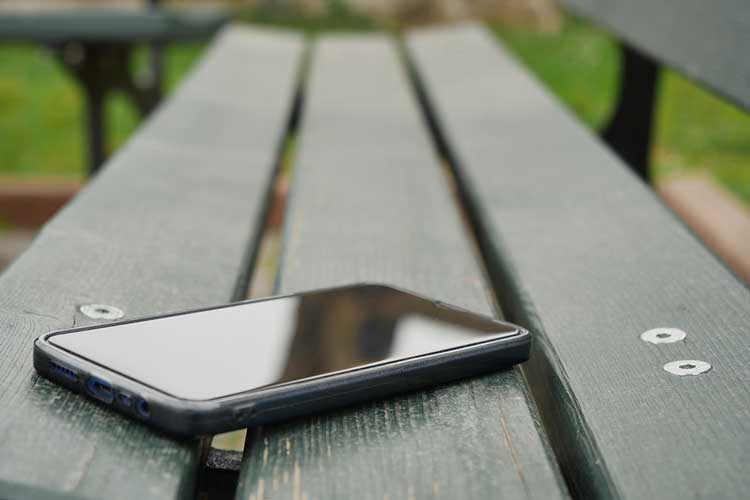Last updated February 2025
What to Do Before—and After—You Lose Your Phone
Do you know your partner’s phone number off the top of your head? Those of your friends? Can you get anywhere without Google Maps?
Our device dependence spells catastrophe if they’re lost or stolen. These pocket-sized computers contain everything from calendars and contacts to access to banking accounts.
If you’ve already misplaced your phone, scroll to the bottom of this article for the next steps. But if you still have it in your possession, take these precautions now.

Before You Lose Your Phone…
Turn on location services for your device. These apps—called “Find My” on Apple and “Find My Device” on Android—allow you to track your smartphone in two ways. They either play a sound (so you can find it if it’s nearby) or use location-sharing if it’s not. If you know your iCloud or Google password, you can log into your account using someone else’s phone or via Apple or Google’s website. Both companies by default enable location sharing; if you turn it off and lose your phone you won’t be able to track down your device—or remotely wipe your data if you can’t get it back.
Password protect your phone. Whether that’s with a PIN or biometric data (your face or thumbprint), lock everything down. That way, if someone does end up with your phone, they can’t immediately access your social media, email, or digital wallet, remotely unlock your home or car, or take advantage of any other app that’s logged in on your device.
Don’t save passwords to an unlocked notes app. If your phone is stolen the thief could access your bank accounts and other sensitive data before you have time to change them or remotely shut down your phone.
Use passkeys instead of passwords and multi-factor authentication (MFA). Unlike passwords, with passkeys there’s no string of letters, numbers, and symbols to remember, nothing to lose or inadvertently share, nothing for criminals to steal, and no way to impersonate your authentication. Instead, when you use a passkey to access an app or website, you approve your sign-in with a PIN, fingerprint, or facial recognition, and criminals can’t get into your passkey-protected accounts from other devices. Click here for more info on how this works.
Not ready to switch? Use a password manager or authenticator app plus a secondary email address for recovery. Don’t rely on just text messages for MFA if you can help it (though for many sites, this is the only option); if a thief has your phone, they’ll get the security texts, too.
Regularly back up your phone to the cloud. That way, when you get a new device, all your contacts, photos, and more can be imported.
Know your IMEI. An IMEI (International Mobile Equipment Identity) is your phone’s identification number. If your device is stolen, you can contact your carrier to lock it down so that thieves can’t sell or use themselves. Your carrier probably already knows this information, but if you’d like it for yourself, dial *#06# and it will pop up on screen regardless of your device’s model or brand. Then, write it down and keep it in a safe place.
After You Lose Your Phone…
Try to locate it using the Find My app specific to your device. But if you suspect it’s been stolen:
Remotely erase the data on your phone. Note that you won’t be able to do this if you’re logged out of Find My or Find My Device. If you can’t remotely wipe your device it’s critical to change your passwords and revoke any active sessions on your phone right away.
If you do have access to Find My or Find My Device:
- For Apple, go to iCloud.com/find, log into your account, select your device, and hit “Erase This Device.” Follow the remaining steps.
- For Android, go to google.com/android/find, log into your account, select your device, and hit “Erase.” Follow the remaining steps.
If your phone is turned off or not connected to Wi-Fi or a cellular network, it will erase the next time it’s turned on or connects.
If you have theft protection, don’t immediately remove the device from your account even if you remotely erase its data. Wait until your claim has been processed and fully approved.
Change your passwords. If you don’t use passkeys or a password manager, make sure you change any login info that could be compromised. This is especially important if you use the same password for multiple accounts.
Revoke all open sessions for your apps. This includes social media, streaming services, banking apps, email accounts, and everything else you use on your phone. You’ll have to do some leg work and visit each website, go to “Settings,” then track down the list of active or approved sessions and revoke the ones logged in on your missing phone.
Reach out to your network provider. They can disable service and use your IMEI to mark the phone as unusable, even with a new SIM card or carrier. This protects you and anyone who unknowingly purchases your stolen phone.
Report the theft to police. You might need a copy of a police report to file any claims.
If you have theft protection, file a claim. Get started with AppleCare+ Theft and Loss or Samsung Care+ to see if they’ll cover a new device.


